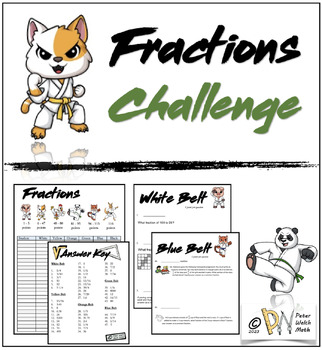Fractions MathCounts Karate Challenge Packet
Peter Welch Math
37 Followers
Grade Levels
5th - 8th
Subjects
Resource Type
Standards
CCSS5.NF.A.1
CCSS5.NF.A.2
CCSS5.NF.B.3
CCSS5.NF.B.4
CCSS5.NF.B.6
Formats Included
- PDF
Pages
25 pages
Peter Welch Math
37 Followers
Description
Challenge 5th, 6th, 7th, and 8th graders to improve their understanding of Fractions with this set of 47 MathCounts questions organized by difficulty level.
Students' problem-solving skills will be pushed to the limit as they advance from White Belt toward Black Belt.
Great for early finishers, advanced learners, or 8th graders needed extra review.
Can occupy a small group of Middle Schoolers for several class periods.
Addresses numerous 5th, 6th, 7th, and 8th grade Fractions, Number Sense, and Ratios & Proportions Standards.
Total Pages
25 pages
Answer Key
Included
Teaching Duration
3 days
Report this resource to TPT
Reported resources will be reviewed by our team. Report this resource to let us know if this resource violates TPT’s content guidelines.
Standards
to see state-specific standards (only available in the US).
CCSS5.NF.A.1
Add and subtract fractions with unlike denominators (including mixed numbers) by replacing given fractions with equivalent fractions in such a way as to produce an equivalent sum or difference of fractions with like denominators. For example, 2/3 + 5/4 = 8/12 + 15/12 = 23/12. (In general, 𝘢/𝘣 + 𝘤/𝘥 = (𝘢𝘥 + 𝘣𝘤)/𝘣𝘥.)
CCSS5.NF.A.2
Solve word problems involving addition and subtraction of fractions referring to the same whole, including cases of unlike denominators, e.g., by using visual fraction models or equations to represent the problem. Use benchmark fractions and number sense of fractions to estimate mentally and assess the reasonableness of answers. For example, recognize an incorrect result 2/5 + 1/2 = 3/7, by observing that 3/7 < 1/2.
CCSS5.NF.B.3
Interpret a fraction as division of the numerator by the denominator (𝘢/𝘣 = 𝘢 ÷ 𝘣). Solve word problems involving division of whole numbers leading to answers in the form of fractions or mixed numbers, e.g., by using visual fraction models or equations to represent the problem. For example, interpret 3/4 as the result of dividing 3 by 4, noting that 3/4 multiplied by 4 equals 3, and that when 3 wholes are shared equally among 4 people each person has a share of size 3/4. If 9 people want to share a 50-pound sack of rice equally by weight, how many pounds of rice should each person get? Between what two whole numbers does your answer lie?
CCSS5.NF.B.4
Apply and extend previous understandings of multiplication to multiply a fraction or whole number by a fraction.
CCSS5.NF.B.6
Solve real world problems involving multiplication of fractions and mixed numbers, e.g., by using visual fraction models or equations to represent the problem.





